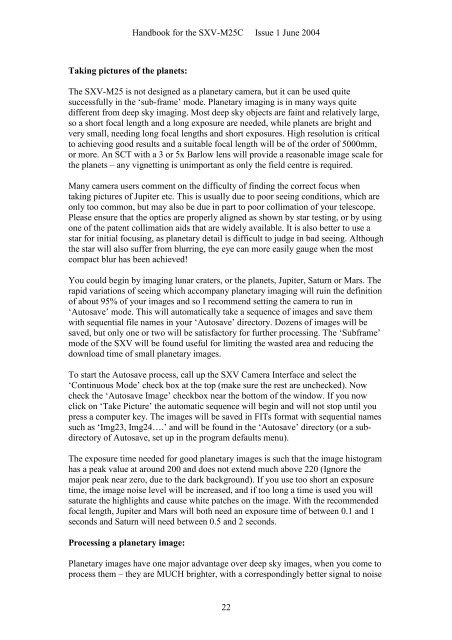SXVF-M25C handbook - Starlight Xpress
SXVF-M25C handbook - Starlight Xpress
SXVF-M25C handbook - Starlight Xpress
Create successful ePaper yourself
Turn your PDF publications into a flip-book with our unique Google optimized e-Paper software.
Handbook for the SXV-<strong>M25C</strong> Issue 1 June 2004<br />
Taking pictures of the planets:<br />
The SXV-M25 is not designed as a planetary camera, but it can be used quite<br />
successfully in the ‘sub-frame’ mode. Planetary imaging is in many ways quite<br />
different from deep sky imaging. Most deep sky objects are faint and relatively large,<br />
so a short focal length and a long exposure are needed, while planets are bright and<br />
very small, needing long focal lengths and short exposures. High resolution is critical<br />
to achieving good results and a suitable focal length will be of the order of 5000mm,<br />
or more. An SCT with a 3 or 5x Barlow lens will provide a reasonable image scale for<br />
the planets – any vignetting is unimportant as only the field centre is required.<br />
Many camera users comment on the difficulty of finding the correct focus when<br />
taking pictures of Jupiter etc. This is usually due to poor seeing conditions, which are<br />
only too common, but may also be due in part to poor collimation of your telescope.<br />
Please ensure that the optics are properly aligned as shown by star testing, or by using<br />
one of the patent collimation aids that are widely available. It is also better to use a<br />
star for initial focusing, as planetary detail is difficult to judge in bad seeing. Although<br />
the star will also suffer from blurring, the eye can more easily gauge when the most<br />
compact blur has been achieved!<br />
You could begin by imaging lunar craters, or the planets, Jupiter, Saturn or Mars. The<br />
rapid variations of seeing which accompany planetary imaging will ruin the definition<br />
of about 95% of your images and so I recommend setting the camera to run in<br />
‘Autosave’ mode. This will automatically take a sequence of images and save them<br />
with sequential file names in your ‘Autosave’ directory. Dozens of images will be<br />
saved, but only one or two will be satisfactory for further processing. The ‘Subframe’<br />
mode of the SXV will be found useful for limiting the wasted area and reducing the<br />
download time of small planetary images.<br />
To start the Autosave process, call up the SXV Camera Interface and select the<br />
‘Continuous Mode’ check box at the top (make sure the rest are unchecked). Now<br />
check the ‘Autosave Image’ checkbox near the bottom of the window. If you now<br />
click on ‘Take Picture’ the automatic sequence will begin and will not stop until you<br />
press a computer key. The images will be saved in FITs format with sequential names<br />
such as ‘Img23, Img24….’ and will be found in the ‘Autosave’ directory (or a subdirectory<br />
of Autosave, set up in the program defaults menu).<br />
The exposure time needed for good planetary images is such that the image histogram<br />
has a peak value at around 200 and does not extend much above 220 (Ignore the<br />
major peak near zero, due to the dark background). If you use too short an exposure<br />
time, the image noise level will be increased, and if too long a time is used you will<br />
saturate the highlights and cause white patches on the image. With the recommended<br />
focal length, Jupiter and Mars will both need an exposure time of between 0.1 and 1<br />
seconds and Saturn will need between 0.5 and 2 seconds.<br />
Processing a planetary image:<br />
Planetary images have one major advantage over deep sky images, when you come to<br />
process them – they are MUCH brighter, with a correspondingly better signal to noise<br />
22

















